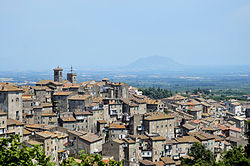Caprarola | |
|---|---|
| Comune di Caprarola | |
 | |
| Coordinates: 42°19′40.3″N 12°14′17.1″E / 42.327861°N 12.238083°E | |
| Country | Italy |
| Region | Lazio |
| Province | Viterbo (VT) |
| Government | |
| • Mayor | Angelo Borgna |
| Area | |
| • Total | 57.58 km2 (22.23 sq mi) |
| Elevation | 520 m (1,710 ft) |
| Population (31 May 2017)[2] | |
| • Total | 5,417 |
| • Density | 94/km2 (240/sq mi) |
| Demonym | Caprolatti |
| Time zone | UTC+1 (CET) |
| • Summer (DST) | UTC+2 (CEST) |
| Postal code | 01032 |
| Dialing code | 0761 |
| Patron saint | St. Egidius |
| Saint day | December 26 |
| Website | Official website |
Caprarola is a town and comune in the province of Viterbo, in the Lazio region of central Italy. The village is situated in a range of volcanic hills known as the Cimini Mounts.
The town is home to the large Renaissance mansion or villa which dominates the surrounding country-side, Villa Farnese (or Villa Caprarola). Not to be confused with the Palazzo Farnese in Rome, it was initially built as a fortress, as the town and the surrounding area was a feud of the House of Farnese, by the cardinal Alessandro Farnese senio in 1530, according to a project of the architect Antonio da Sangallo the Younger. After only four years the project came to a halt when the cardinal was elected pope in 1534 under the name Paul III.
Filmography
[edit]Villa Farnese was used as film location in many movies and TV series, such as Medici: Masters of Florence, The Man From Uncle and The Two Popes.
References
[edit]- ^ "Superficie di Comuni Province e Regioni italiane al 9 ottobre 2011". Italian National Institute of Statistics. Retrieved 16 March 2019.
- ^ All demographics and other statistics: Italian statistical institute Istat.



Well, that’s interesting to know that Psilotum nudum are known as whisk ferns. Psilotum nudum is the commoner species of the two. While the P. flaccidum is a rare species and is found in the tropical islands. Both the species are usually epiphytic in habit and grow upon tree ferns. These species may also be terrestrial and grow in humus or in the crevices of the rocks.
View the detailed Guide of Psilotum nudum: Detailed Study Of Psilotum Nudum (Whisk Fern), Classification, Anatomy, Reproduction